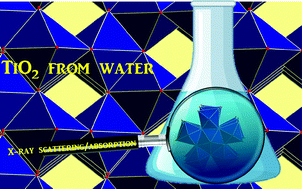The role of titanium-oxo clusters in the sulfate process for TiO2 production†
Abstract
TiO2 is manufactured for white pigments, solar cells, self-cleaning surfaces and devices, and other photocatalytic applications. The industrial synthesis of TiO2 entails: (1) the dissolution of ilmenite ore (FeTiO3) in aqueous sulfuric acid which precipitates the Fe while retaining the Ti in solution, followed by (2) dilution or heating the Ti sulfate solution to precipitate the pure form of TiO2. The underlying chemistry of these processing steps remains poorly understood. Here we show that the dissolution of a simple TiIV-sulfate salt, representative of the industrial sulfate process for the production of TiO2, immediately self-assembles into a soluble Ti-octadecameric cluster, denoted as {Ti18}. We observed {Ti18} in solution by small-angle X-ray scattering and Ti extended X-ray absorption fine structure (Ti-EXAFS) analysis, and ultimately crystallized it for absolute identification. The {Ti18} metal-oxo cluster was previously reported as a polycation; but shown here, it can also be a polyanion, dependent on the number of sulfate ligands it carries. After immediate self-assembly, the {Ti18}-cluster persists until TiO2 precipitates, with no easily identified structural intermediates in the solution or solid state, despite the fact that the atomic arrangement of {Ti18} differs vastly from that of titania. The evolution from solution phase {Ti18} to precipitated TiO2 nanoparticles was detailed by X-ray scattering and Ti-EXAFS. We offer a hypothesis for the key mechanism of complete separation of Fe from Ti in the industrial sulfate process. These findings also highlight the emerging importance of the unusual Ti(Ti)5 pentagonal building unit, featured in {Ti18} as well as other early d0 transition metal-oxo clusters including Nb, Mo and W. Finally, this study presents an example of crystal growth mechanisms in which the observed “pre-nucleation cluster” does not necessarily predicate the structure of the precipitated solid.



 Please wait while we load your content...
Please wait while we load your content...
